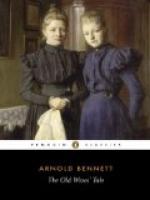A reversion, conceivably, to a mediaeval type! Yes, but also the exemplar of the excessively modern! Externally he was a consequence of the fact that, years previously, the leading tailor in Bursley had permitted his son to be apprenticed in London. The father died; the son had the wit to return and make a fortune while creating a new type in the town, a type of which multiple chains were but one feature, and that the least expensive if the most salient. For instance, up to the historic year in which the young tailor created the type, any cap was a cap in Bursley, and any collar was a collar. But thenceforward no cap was a cap, and no collar was a collar, which did not exactly conform in shape and material to certain sacred caps and collars guarded by the young tailor in his back shop. None knew why these sacred caps and collars were sacred, but they were; their sacredness endured for about six months, and then suddenly—again none knew why—they fell from their estate and became lower than offal for dogs, and were supplanted on the altar. The type brought into existence by the young tailor was to be recognized by its caps and collars, and in a similar manner by every other article of attire, except its boots. Unfortunately the tailor did not sell boots, and so imposed on his creatures no mystical creed as to boots. This was a pity, for the boot-makers of the town happened not to be inflamed by the type-creating passion as the tailor was, and thus the new type finished abruptly at the edges of the tailor’s trousers.
The man at No. 4, St. Luke’s Square had comparatively small and narrow feet, which gave him an advantage; and as he was endowed with a certain vague general physical distinction he managed, despite the eternal untidiness of his hair, to be eminent among the type. Assuredly the frequent sight of him in her house flattered the pride of Constance’s eye, which rested on him almost always with pleasure. He had come into the house with startling abruptness soon after Cyril left school and was indentured to the head-designer at “Peel’s,” that classic earthenware manufactory. The presence of a man in her abode disconcerted Constance at the beginning; but she soon grew accustomed to it, perceiving that a man would behave as a man, and must be expected to do so. This man, in truth, did what he liked in all things. Cyril having always been regarded by both his parents as enormous, one would have anticipated a giant in the new man; but, queerly, he was slim, and little above the average height. Neither in enormity nor in many other particulars did he resemble the Cyril whom he had supplanted. His gestures were lighter and quicker; he had nothing of Cyril’s ungainliness; he had not Cyril’s limitless taste for sweets, nor Cyril’s terrific hatred of gloves, barbers, and soap. He was much more dreamy than Cyril, and much busier. In fact, Constance only saw him at meal-times. He was at Peel’s in the day and at the School of Art every night. He would dream during a meal, even; and, without actually saying so, he gave the impression that he was the busiest man in Bursley, wrapped in occupations and preoccupations as in a blanket—a blanket which Constance had difficulty in penetrating.




